Developing Individuals, Teams, and Organizations: Toyota HR Report
VerifiedAdded on 2023/01/19
|14
|3222
|69
Report
AI Summary
This report examines human resource management within Toyota, focusing on the essential skills, knowledge, and behaviors required of HR professionals. It includes a personal skill audit and a professional development plan. The report differentiates between individual and organizational learning, exploring the benefits of continuous professional development in driving business performance. It analyzes the contribution of high-performance working (HPW) systems to employee engagement and discusses various performance management approaches. The report aims to provide a comprehensive overview of HR practices, contributing to Toyota's goal of enhancing productivity and gaining a competitive advantage in the automobile industry. This report offers valuable insights into how Toyota can effectively manage its workforce to achieve its organizational objectives.
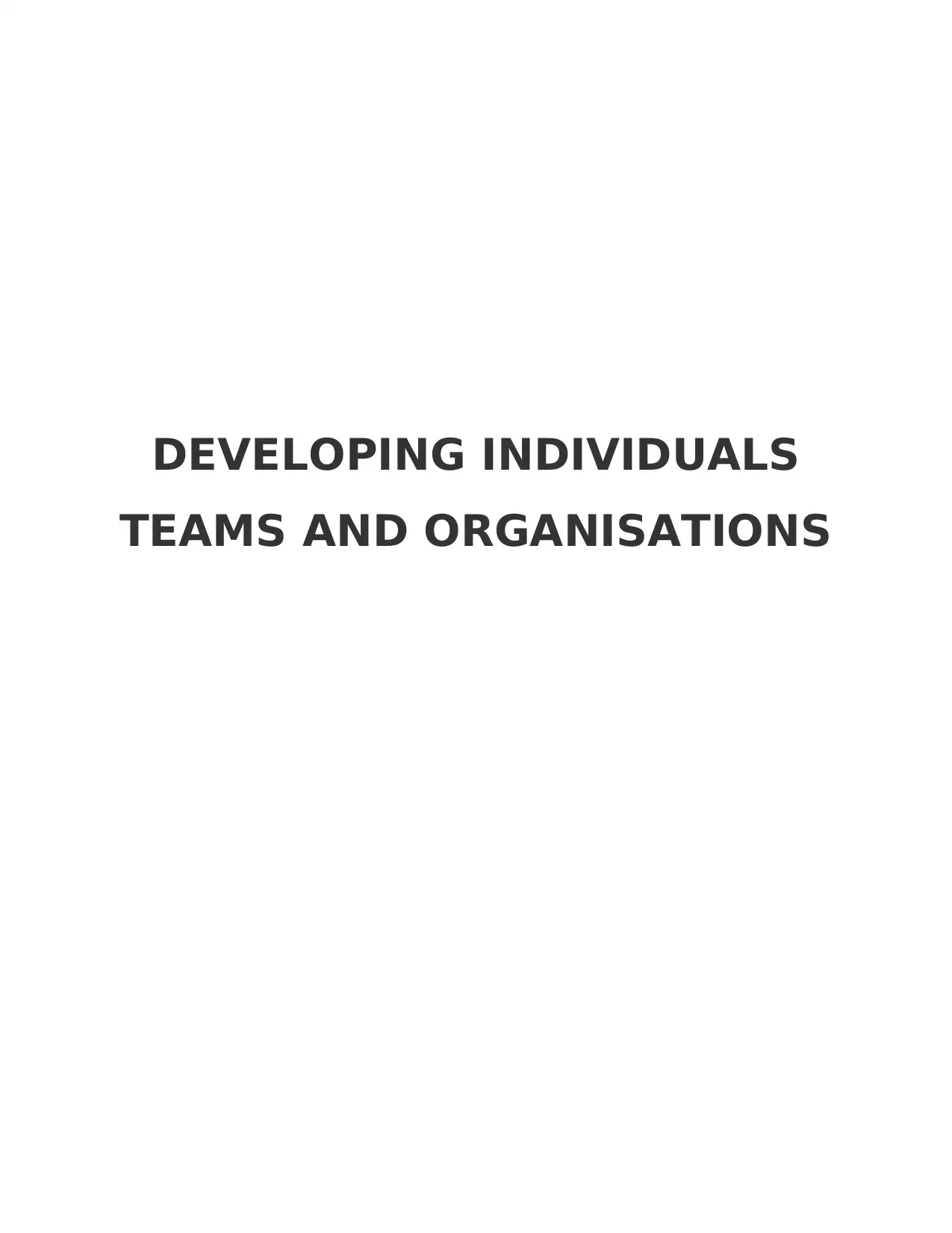
DEVELOPING INDIVIDUALS
TEAMS AND ORGANISATIONS
TEAMS AND ORGANISATIONS
Paraphrase This Document
Need a fresh take? Get an instant paraphrase of this document with our AI Paraphraser
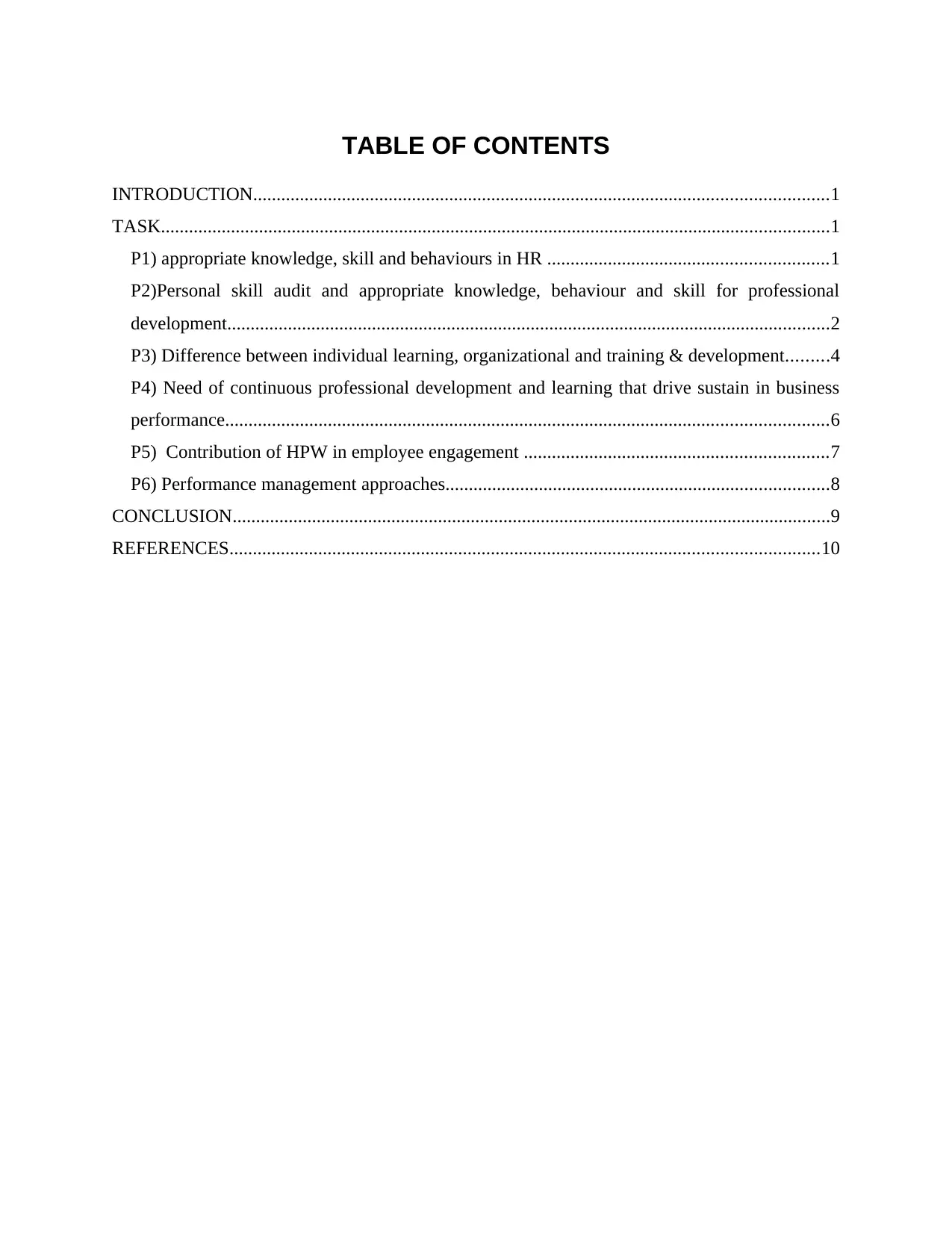
TABLE OF CONTENTS
INTRODUCTION...........................................................................................................................1
TASK...............................................................................................................................................1
P1) appropriate knowledge, skill and behaviours in HR ............................................................1
P2)Personal skill audit and appropriate knowledge, behaviour and skill for professional
development.................................................................................................................................2
P3) Difference between individual learning, organizational and training & development.........4
P4) Need of continuous professional development and learning that drive sustain in business
performance.................................................................................................................................6
P5) Contribution of HPW in employee engagement .................................................................7
P6) Performance management approaches..................................................................................8
CONCLUSION................................................................................................................................9
REFERENCES..............................................................................................................................10
INTRODUCTION...........................................................................................................................1
TASK...............................................................................................................................................1
P1) appropriate knowledge, skill and behaviours in HR ............................................................1
P2)Personal skill audit and appropriate knowledge, behaviour and skill for professional
development.................................................................................................................................2
P3) Difference between individual learning, organizational and training & development.........4
P4) Need of continuous professional development and learning that drive sustain in business
performance.................................................................................................................................6
P5) Contribution of HPW in employee engagement .................................................................7
P6) Performance management approaches..................................................................................8
CONCLUSION................................................................................................................................9
REFERENCES..............................................................................................................................10
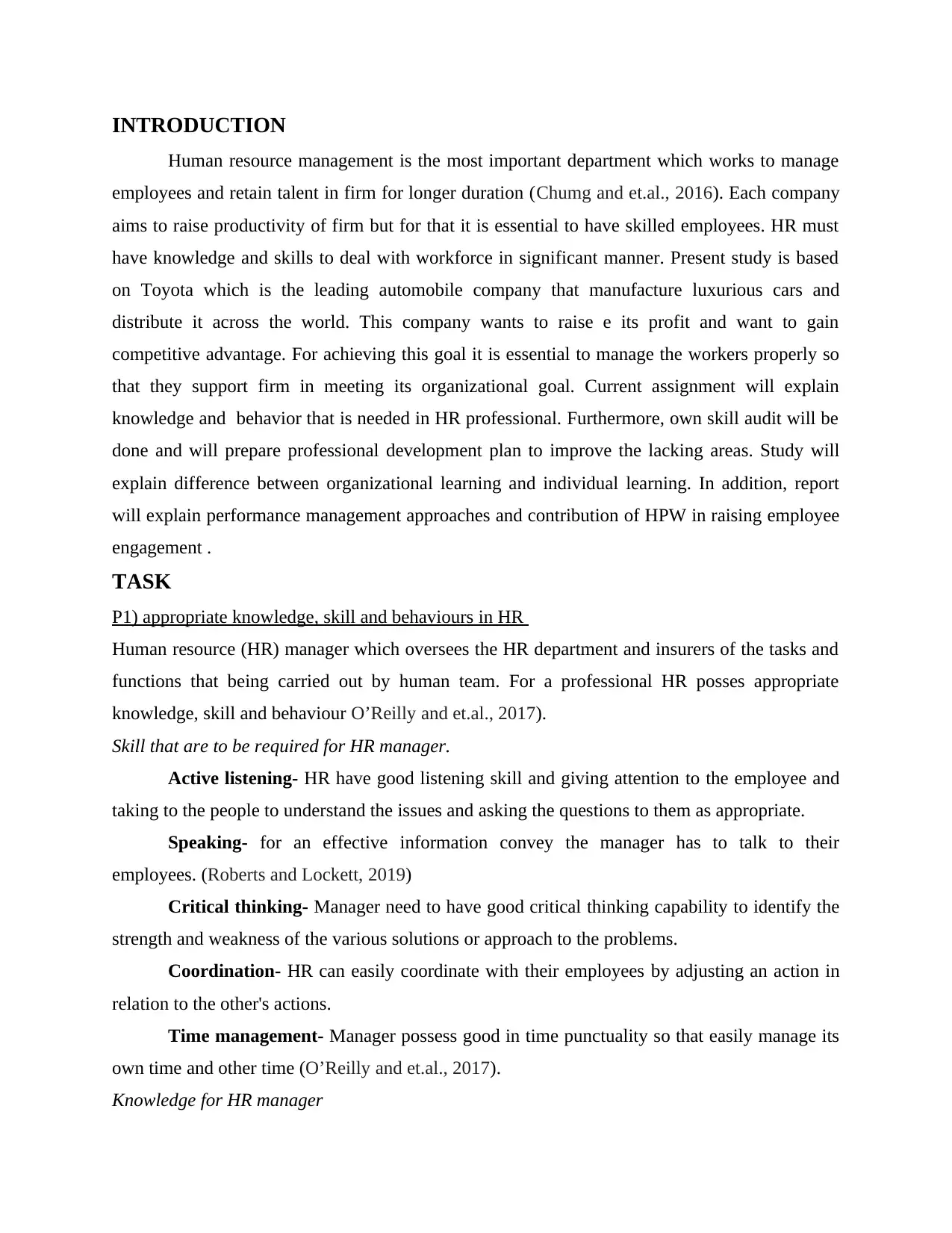
INTRODUCTION
Human resource management is the most important department which works to manage
employees and retain talent in firm for longer duration (Chumg and et.al., 2016). Each company
aims to raise productivity of firm but for that it is essential to have skilled employees. HR must
have knowledge and skills to deal with workforce in significant manner. Present study is based
on Toyota which is the leading automobile company that manufacture luxurious cars and
distribute it across the world. This company wants to raise e its profit and want to gain
competitive advantage. For achieving this goal it is essential to manage the workers properly so
that they support firm in meeting its organizational goal. Current assignment will explain
knowledge and behavior that is needed in HR professional. Furthermore, own skill audit will be
done and will prepare professional development plan to improve the lacking areas. Study will
explain difference between organizational learning and individual learning. In addition, report
will explain performance management approaches and contribution of HPW in raising employee
engagement .
TASK
P1) appropriate knowledge, skill and behaviours in HR
Human resource (HR) manager which oversees the HR department and insurers of the tasks and
functions that being carried out by human team. For a professional HR posses appropriate
knowledge, skill and behaviour O’Reilly and et.al., 2017).
Skill that are to be required for HR manager.
Active listening- HR have good listening skill and giving attention to the employee and
taking to the people to understand the issues and asking the questions to them as appropriate.
Speaking- for an effective information convey the manager has to talk to their
employees. (Roberts and Lockett, 2019)
Critical thinking- Manager need to have good critical thinking capability to identify the
strength and weakness of the various solutions or approach to the problems.
Coordination- HR can easily coordinate with their employees by adjusting an action in
relation to the other's actions.
Time management- Manager possess good in time punctuality so that easily manage its
own time and other time (O’Reilly and et.al., 2017).
Knowledge for HR manager
Human resource management is the most important department which works to manage
employees and retain talent in firm for longer duration (Chumg and et.al., 2016). Each company
aims to raise productivity of firm but for that it is essential to have skilled employees. HR must
have knowledge and skills to deal with workforce in significant manner. Present study is based
on Toyota which is the leading automobile company that manufacture luxurious cars and
distribute it across the world. This company wants to raise e its profit and want to gain
competitive advantage. For achieving this goal it is essential to manage the workers properly so
that they support firm in meeting its organizational goal. Current assignment will explain
knowledge and behavior that is needed in HR professional. Furthermore, own skill audit will be
done and will prepare professional development plan to improve the lacking areas. Study will
explain difference between organizational learning and individual learning. In addition, report
will explain performance management approaches and contribution of HPW in raising employee
engagement .
TASK
P1) appropriate knowledge, skill and behaviours in HR
Human resource (HR) manager which oversees the HR department and insurers of the tasks and
functions that being carried out by human team. For a professional HR posses appropriate
knowledge, skill and behaviour O’Reilly and et.al., 2017).
Skill that are to be required for HR manager.
Active listening- HR have good listening skill and giving attention to the employee and
taking to the people to understand the issues and asking the questions to them as appropriate.
Speaking- for an effective information convey the manager has to talk to their
employees. (Roberts and Lockett, 2019)
Critical thinking- Manager need to have good critical thinking capability to identify the
strength and weakness of the various solutions or approach to the problems.
Coordination- HR can easily coordinate with their employees by adjusting an action in
relation to the other's actions.
Time management- Manager possess good in time punctuality so that easily manage its
own time and other time (O’Reilly and et.al., 2017).
Knowledge for HR manager
⊘ This is a preview!⊘
Do you want full access?
Subscribe today to unlock all pages.

Trusted by 1+ million students worldwide
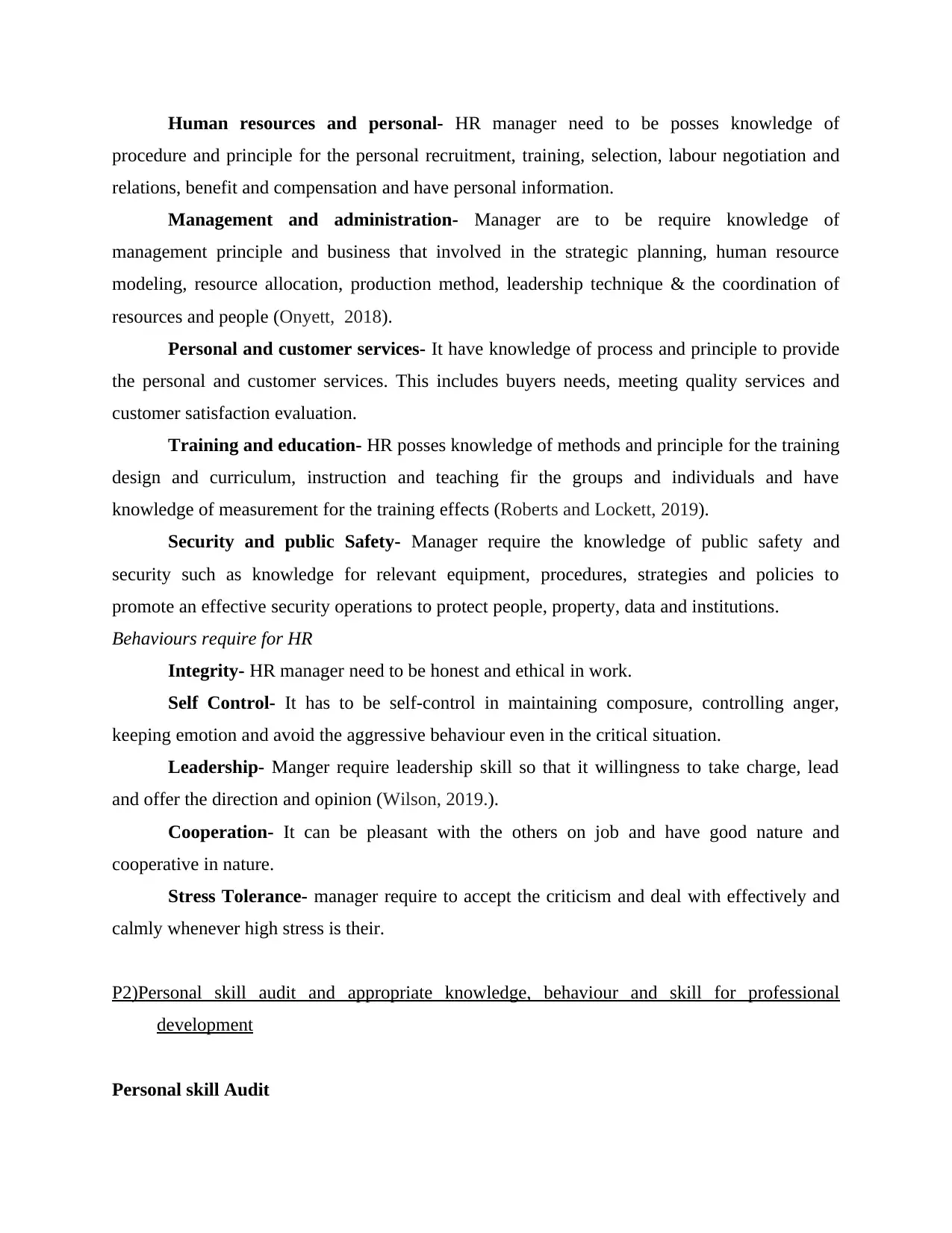
Human resources and personal- HR manager need to be posses knowledge of
procedure and principle for the personal recruitment, training, selection, labour negotiation and
relations, benefit and compensation and have personal information.
Management and administration- Manager are to be require knowledge of
management principle and business that involved in the strategic planning, human resource
modeling, resource allocation, production method, leadership technique & the coordination of
resources and people (Onyett, 2018).
Personal and customer services- It have knowledge of process and principle to provide
the personal and customer services. This includes buyers needs, meeting quality services and
customer satisfaction evaluation.
Training and education- HR posses knowledge of methods and principle for the training
design and curriculum, instruction and teaching fir the groups and individuals and have
knowledge of measurement for the training effects (Roberts and Lockett, 2019).
Security and public Safety- Manager require the knowledge of public safety and
security such as knowledge for relevant equipment, procedures, strategies and policies to
promote an effective security operations to protect people, property, data and institutions.
Behaviours require for HR
Integrity- HR manager need to be honest and ethical in work.
Self Control- It has to be self-control in maintaining composure, controlling anger,
keeping emotion and avoid the aggressive behaviour even in the critical situation.
Leadership- Manger require leadership skill so that it willingness to take charge, lead
and offer the direction and opinion (Wilson, 2019.).
Cooperation- It can be pleasant with the others on job and have good nature and
cooperative in nature.
Stress Tolerance- manager require to accept the criticism and deal with effectively and
calmly whenever high stress is their.
P2)Personal skill audit and appropriate knowledge, behaviour and skill for professional
development
Personal skill Audit
procedure and principle for the personal recruitment, training, selection, labour negotiation and
relations, benefit and compensation and have personal information.
Management and administration- Manager are to be require knowledge of
management principle and business that involved in the strategic planning, human resource
modeling, resource allocation, production method, leadership technique & the coordination of
resources and people (Onyett, 2018).
Personal and customer services- It have knowledge of process and principle to provide
the personal and customer services. This includes buyers needs, meeting quality services and
customer satisfaction evaluation.
Training and education- HR posses knowledge of methods and principle for the training
design and curriculum, instruction and teaching fir the groups and individuals and have
knowledge of measurement for the training effects (Roberts and Lockett, 2019).
Security and public Safety- Manager require the knowledge of public safety and
security such as knowledge for relevant equipment, procedures, strategies and policies to
promote an effective security operations to protect people, property, data and institutions.
Behaviours require for HR
Integrity- HR manager need to be honest and ethical in work.
Self Control- It has to be self-control in maintaining composure, controlling anger,
keeping emotion and avoid the aggressive behaviour even in the critical situation.
Leadership- Manger require leadership skill so that it willingness to take charge, lead
and offer the direction and opinion (Wilson, 2019.).
Cooperation- It can be pleasant with the others on job and have good nature and
cooperative in nature.
Stress Tolerance- manager require to accept the criticism and deal with effectively and
calmly whenever high stress is their.
P2)Personal skill audit and appropriate knowledge, behaviour and skill for professional
development
Personal skill Audit
Paraphrase This Document
Need a fresh take? Get an instant paraphrase of this document with our AI Paraphraser
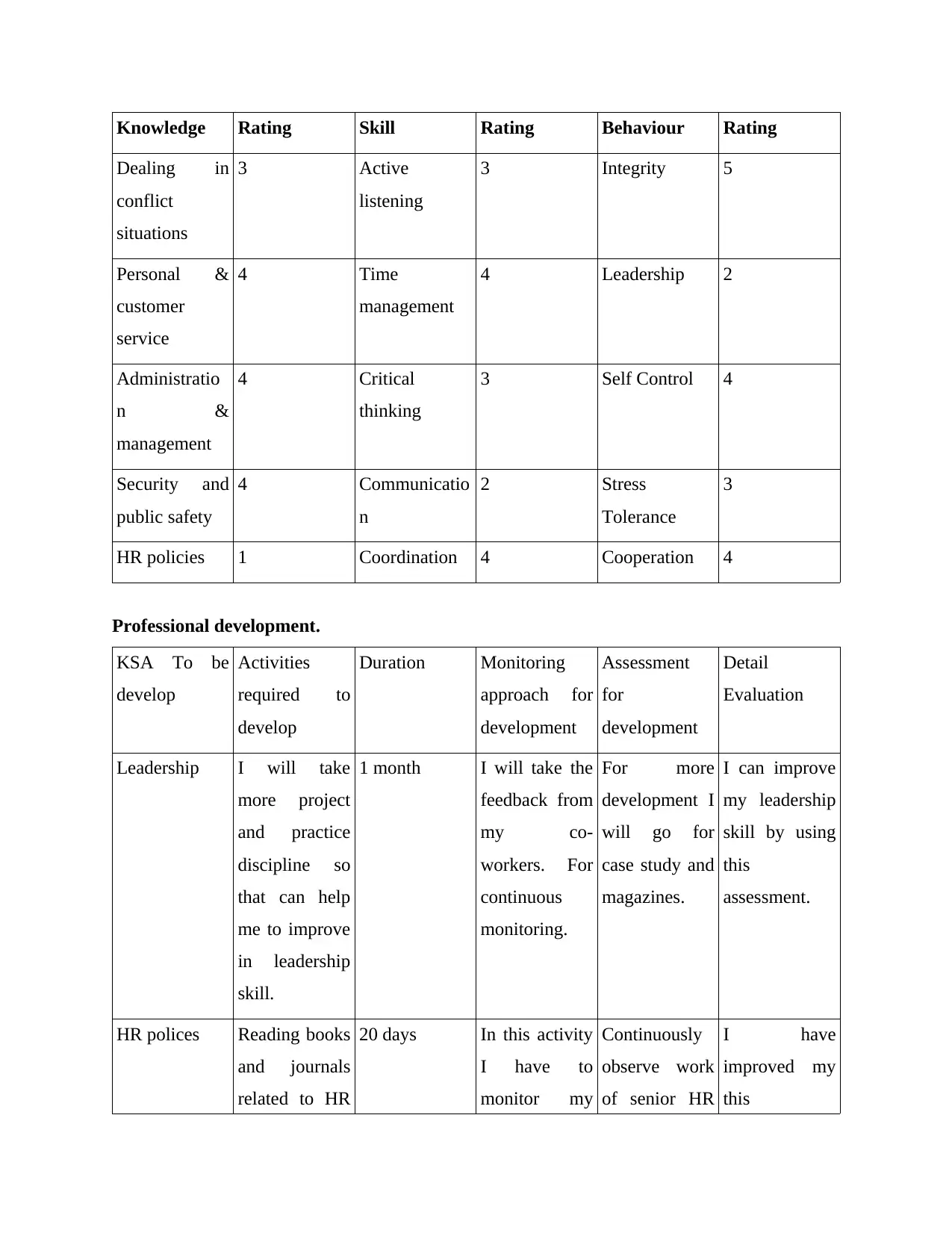
Knowledge Rating Skill Rating Behaviour Rating
Dealing in
conflict
situations
3 Active
listening
3 Integrity 5
Personal &
customer
service
4 Time
management
4 Leadership 2
Administratio
n &
management
4 Critical
thinking
3 Self Control 4
Security and
public safety
4 Communicatio
n
2 Stress
Tolerance
3
HR policies 1 Coordination 4 Cooperation 4
Professional development.
KSA To be
develop
Activities
required to
develop
Duration Monitoring
approach for
development
Assessment
for
development
Detail
Evaluation
Leadership I will take
more project
and practice
discipline so
that can help
me to improve
in leadership
skill.
1 month I will take the
feedback from
my co-
workers. For
continuous
monitoring.
For more
development I
will go for
case study and
magazines.
I can improve
my leadership
skill by using
this
assessment.
HR polices Reading books
and journals
related to HR
20 days In this activity
I have to
monitor my
Continuously
observe work
of senior HR
I have
improved my
this
Dealing in
conflict
situations
3 Active
listening
3 Integrity 5
Personal &
customer
service
4 Time
management
4 Leadership 2
Administratio
n &
management
4 Critical
thinking
3 Self Control 4
Security and
public safety
4 Communicatio
n
2 Stress
Tolerance
3
HR policies 1 Coordination 4 Cooperation 4
Professional development.
KSA To be
develop
Activities
required to
develop
Duration Monitoring
approach for
development
Assessment
for
development
Detail
Evaluation
Leadership I will take
more project
and practice
discipline so
that can help
me to improve
in leadership
skill.
1 month I will take the
feedback from
my co-
workers. For
continuous
monitoring.
For more
development I
will go for
case study and
magazines.
I can improve
my leadership
skill by using
this
assessment.
HR polices Reading books
and journals
related to HR
20 days In this activity
I have to
monitor my
Continuously
observe work
of senior HR
I have
improved my
this
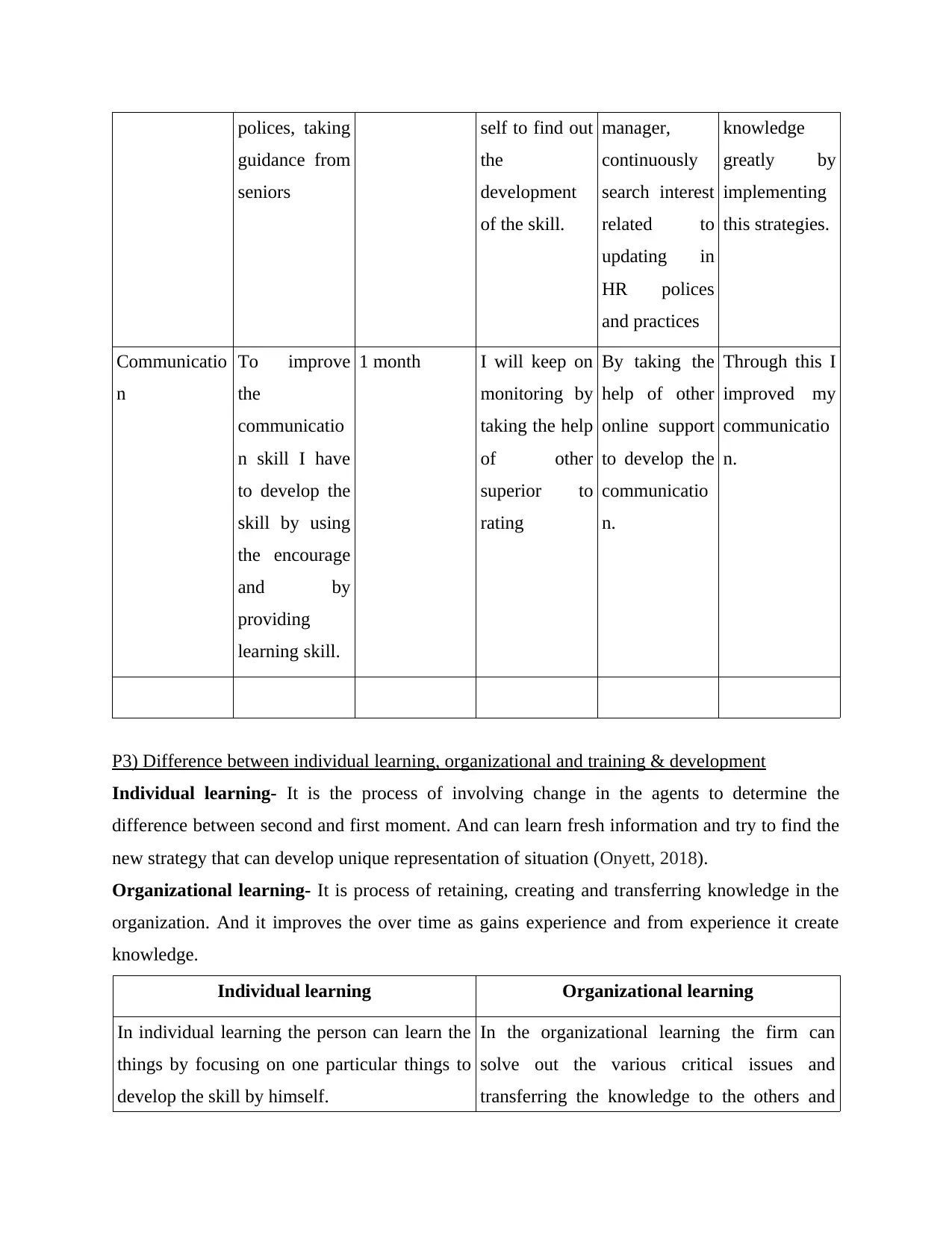
polices, taking
guidance from
seniors
self to find out
the
development
of the skill.
manager,
continuously
search interest
related to
updating in
HR polices
and practices
knowledge
greatly by
implementing
this strategies.
Communicatio
n
To improve
the
communicatio
n skill I have
to develop the
skill by using
the encourage
and by
providing
learning skill.
1 month I will keep on
monitoring by
taking the help
of other
superior to
rating
By taking the
help of other
online support
to develop the
communicatio
n.
Through this I
improved my
communicatio
n.
P3) Difference between individual learning, organizational and training & development
Individual learning- It is the process of involving change in the agents to determine the
difference between second and first moment. And can learn fresh information and try to find the
new strategy that can develop unique representation of situation (Onyett, 2018).
Organizational learning- It is process of retaining, creating and transferring knowledge in the
organization. And it improves the over time as gains experience and from experience it create
knowledge.
Individual learning Organizational learning
In individual learning the person can learn the
things by focusing on one particular things to
develop the skill by himself.
In the organizational learning the firm can
solve out the various critical issues and
transferring the knowledge to the others and
guidance from
seniors
self to find out
the
development
of the skill.
manager,
continuously
search interest
related to
updating in
HR polices
and practices
knowledge
greatly by
implementing
this strategies.
Communicatio
n
To improve
the
communicatio
n skill I have
to develop the
skill by using
the encourage
and by
providing
learning skill.
1 month I will keep on
monitoring by
taking the help
of other
superior to
rating
By taking the
help of other
online support
to develop the
communicatio
n.
Through this I
improved my
communicatio
n.
P3) Difference between individual learning, organizational and training & development
Individual learning- It is the process of involving change in the agents to determine the
difference between second and first moment. And can learn fresh information and try to find the
new strategy that can develop unique representation of situation (Onyett, 2018).
Organizational learning- It is process of retaining, creating and transferring knowledge in the
organization. And it improves the over time as gains experience and from experience it create
knowledge.
Individual learning Organizational learning
In individual learning the person can learn the
things by focusing on one particular things to
develop the skill by himself.
In the organizational learning the firm can
solve out the various critical issues and
transferring the knowledge to the others and
⊘ This is a preview!⊘
Do you want full access?
Subscribe today to unlock all pages.

Trusted by 1+ million students worldwide
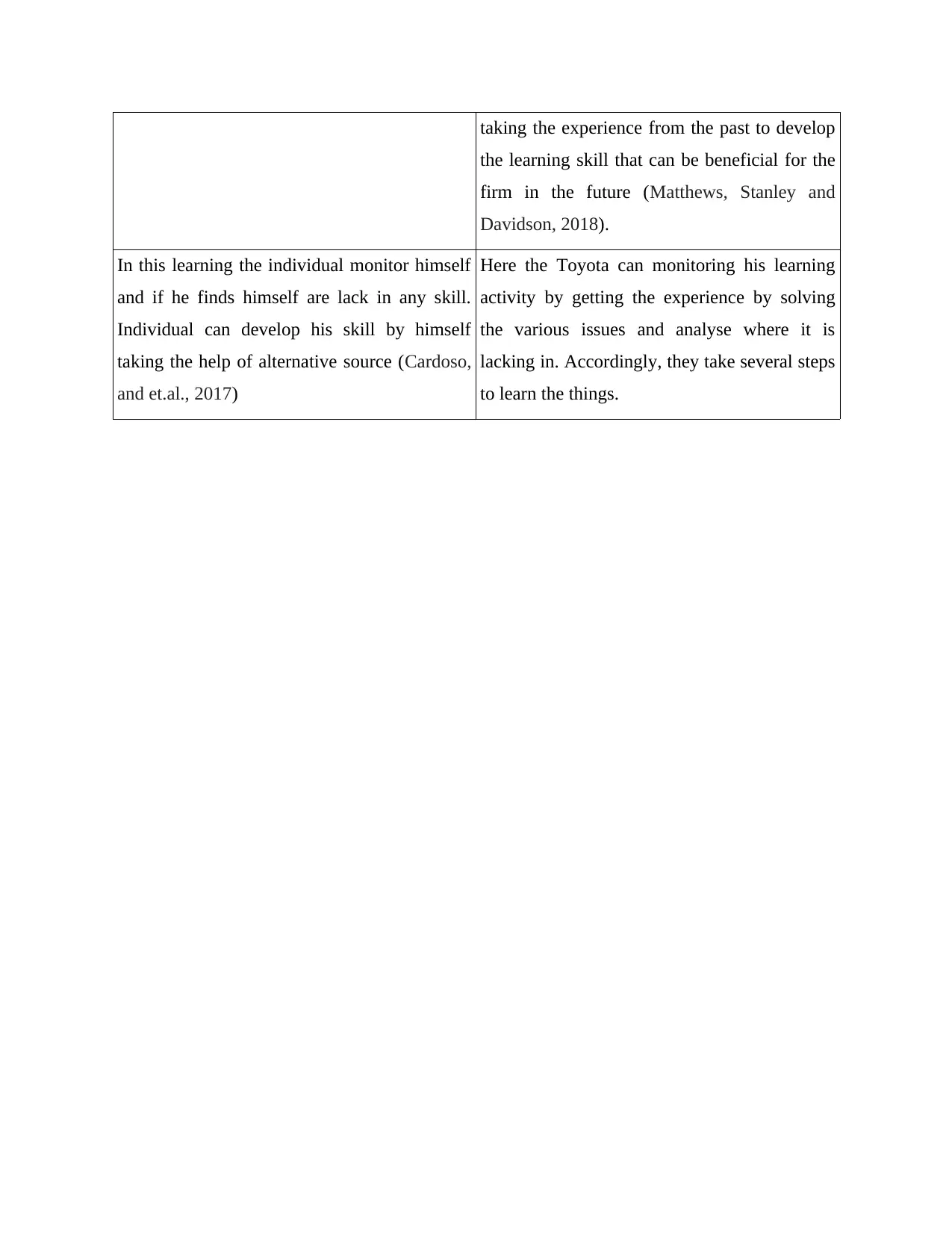
taking the experience from the past to develop
the learning skill that can be beneficial for the
firm in the future (Matthews, Stanley and
Davidson, 2018).
In this learning the individual monitor himself
and if he finds himself are lack in any skill.
Individual can develop his skill by himself
taking the help of alternative source (Cardoso,
and et.al., 2017)
Here the Toyota can monitoring his learning
activity by getting the experience by solving
the various issues and analyse where it is
lacking in. Accordingly, they take several steps
to learn the things.
the learning skill that can be beneficial for the
firm in the future (Matthews, Stanley and
Davidson, 2018).
In this learning the individual monitor himself
and if he finds himself are lack in any skill.
Individual can develop his skill by himself
taking the help of alternative source (Cardoso,
and et.al., 2017)
Here the Toyota can monitoring his learning
activity by getting the experience by solving
the various issues and analyse where it is
lacking in. Accordingly, they take several steps
to learn the things.
Paraphrase This Document
Need a fresh take? Get an instant paraphrase of this document with our AI Paraphraser
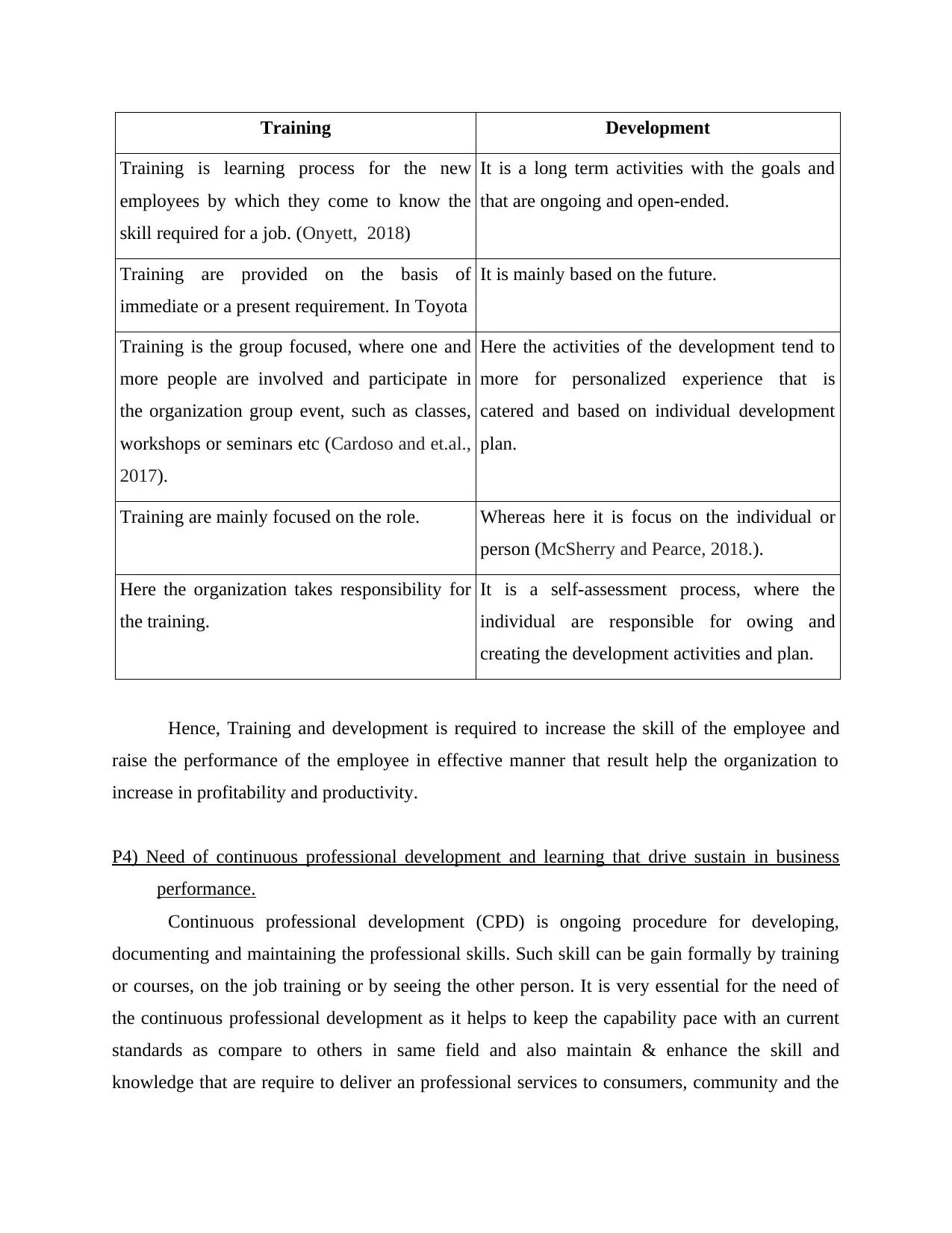
Training Development
Training is learning process for the new
employees by which they come to know the
skill required for a job. (Onyett, 2018)
It is a long term activities with the goals and
that are ongoing and open-ended.
Training are provided on the basis of
immediate or a present requirement. In Toyota
It is mainly based on the future.
Training is the group focused, where one and
more people are involved and participate in
the organization group event, such as classes,
workshops or seminars etc (Cardoso and et.al.,
2017).
Here the activities of the development tend to
more for personalized experience that is
catered and based on individual development
plan.
Training are mainly focused on the role. Whereas here it is focus on the individual or
person (McSherry and Pearce, 2018.).
Here the organization takes responsibility for
the training.
It is a self-assessment process, where the
individual are responsible for owing and
creating the development activities and plan.
Hence, Training and development is required to increase the skill of the employee and
raise the performance of the employee in effective manner that result help the organization to
increase in profitability and productivity.
P4) Need of continuous professional development and learning that drive sustain in business
performance.
Continuous professional development (CPD) is ongoing procedure for developing,
documenting and maintaining the professional skills. Such skill can be gain formally by training
or courses, on the job training or by seeing the other person. It is very essential for the need of
the continuous professional development as it helps to keep the capability pace with an current
standards as compare to others in same field and also maintain & enhance the skill and
knowledge that are require to deliver an professional services to consumers, community and the
Training is learning process for the new
employees by which they come to know the
skill required for a job. (Onyett, 2018)
It is a long term activities with the goals and
that are ongoing and open-ended.
Training are provided on the basis of
immediate or a present requirement. In Toyota
It is mainly based on the future.
Training is the group focused, where one and
more people are involved and participate in
the organization group event, such as classes,
workshops or seminars etc (Cardoso and et.al.,
2017).
Here the activities of the development tend to
more for personalized experience that is
catered and based on individual development
plan.
Training are mainly focused on the role. Whereas here it is focus on the individual or
person (McSherry and Pearce, 2018.).
Here the organization takes responsibility for
the training.
It is a self-assessment process, where the
individual are responsible for owing and
creating the development activities and plan.
Hence, Training and development is required to increase the skill of the employee and
raise the performance of the employee in effective manner that result help the organization to
increase in profitability and productivity.
P4) Need of continuous professional development and learning that drive sustain in business
performance.
Continuous professional development (CPD) is ongoing procedure for developing,
documenting and maintaining the professional skills. Such skill can be gain formally by training
or courses, on the job training or by seeing the other person. It is very essential for the need of
the continuous professional development as it helps to keep the capability pace with an current
standards as compare to others in same field and also maintain & enhance the skill and
knowledge that are require to deliver an professional services to consumers, community and the
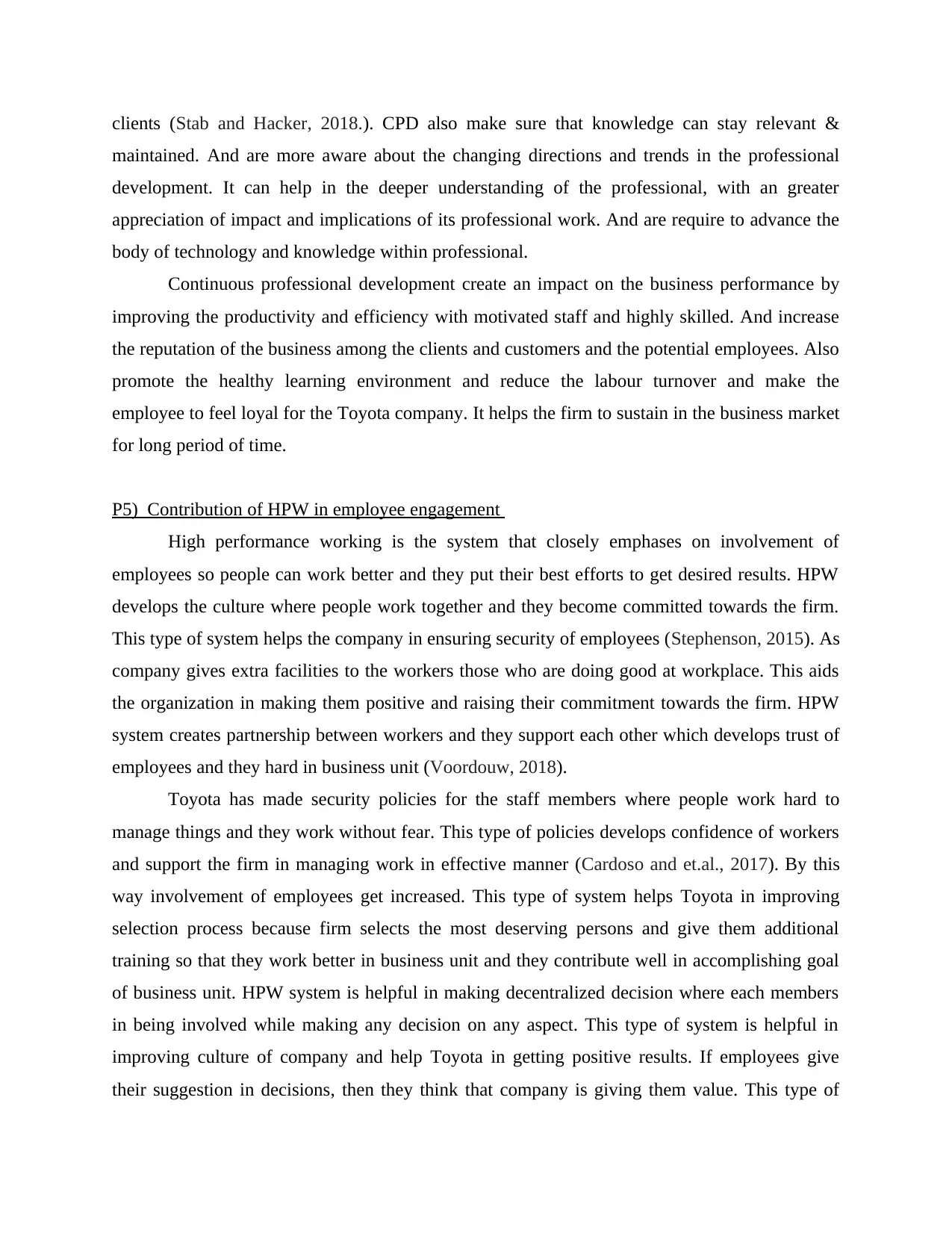
clients (Stab and Hacker, 2018.). CPD also make sure that knowledge can stay relevant &
maintained. And are more aware about the changing directions and trends in the professional
development. It can help in the deeper understanding of the professional, with an greater
appreciation of impact and implications of its professional work. And are require to advance the
body of technology and knowledge within professional.
Continuous professional development create an impact on the business performance by
improving the productivity and efficiency with motivated staff and highly skilled. And increase
the reputation of the business among the clients and customers and the potential employees. Also
promote the healthy learning environment and reduce the labour turnover and make the
employee to feel loyal for the Toyota company. It helps the firm to sustain in the business market
for long period of time.
P5) Contribution of HPW in employee engagement
High performance working is the system that closely emphases on involvement of
employees so people can work better and they put their best efforts to get desired results. HPW
develops the culture where people work together and they become committed towards the firm.
This type of system helps the company in ensuring security of employees (Stephenson, 2015). As
company gives extra facilities to the workers those who are doing good at workplace. This aids
the organization in making them positive and raising their commitment towards the firm. HPW
system creates partnership between workers and they support each other which develops trust of
employees and they hard in business unit (Voordouw, 2018).
Toyota has made security policies for the staff members where people work hard to
manage things and they work without fear. This type of policies develops confidence of workers
and support the firm in managing work in effective manner (Cardoso and et.al., 2017). By this
way involvement of employees get increased. This type of system helps Toyota in improving
selection process because firm selects the most deserving persons and give them additional
training so that they work better in business unit and they contribute well in accomplishing goal
of business unit. HPW system is helpful in making decentralized decision where each members
in being involved while making any decision on any aspect. This type of system is helpful in
improving culture of company and help Toyota in getting positive results. If employees give
their suggestion in decisions, then they think that company is giving them value. This type of
maintained. And are more aware about the changing directions and trends in the professional
development. It can help in the deeper understanding of the professional, with an greater
appreciation of impact and implications of its professional work. And are require to advance the
body of technology and knowledge within professional.
Continuous professional development create an impact on the business performance by
improving the productivity and efficiency with motivated staff and highly skilled. And increase
the reputation of the business among the clients and customers and the potential employees. Also
promote the healthy learning environment and reduce the labour turnover and make the
employee to feel loyal for the Toyota company. It helps the firm to sustain in the business market
for long period of time.
P5) Contribution of HPW in employee engagement
High performance working is the system that closely emphases on involvement of
employees so people can work better and they put their best efforts to get desired results. HPW
develops the culture where people work together and they become committed towards the firm.
This type of system helps the company in ensuring security of employees (Stephenson, 2015). As
company gives extra facilities to the workers those who are doing good at workplace. This aids
the organization in making them positive and raising their commitment towards the firm. HPW
system creates partnership between workers and they support each other which develops trust of
employees and they hard in business unit (Voordouw, 2018).
Toyota has made security policies for the staff members where people work hard to
manage things and they work without fear. This type of policies develops confidence of workers
and support the firm in managing work in effective manner (Cardoso and et.al., 2017). By this
way involvement of employees get increased. This type of system helps Toyota in improving
selection process because firm selects the most deserving persons and give them additional
training so that they work better in business unit and they contribute well in accomplishing goal
of business unit. HPW system is helpful in making decentralized decision where each members
in being involved while making any decision on any aspect. This type of system is helpful in
improving culture of company and help Toyota in getting positive results. If employees give
their suggestion in decisions, then they think that company is giving them value. This type of
⊘ This is a preview!⊘
Do you want full access?
Subscribe today to unlock all pages.

Trusted by 1+ million students worldwide
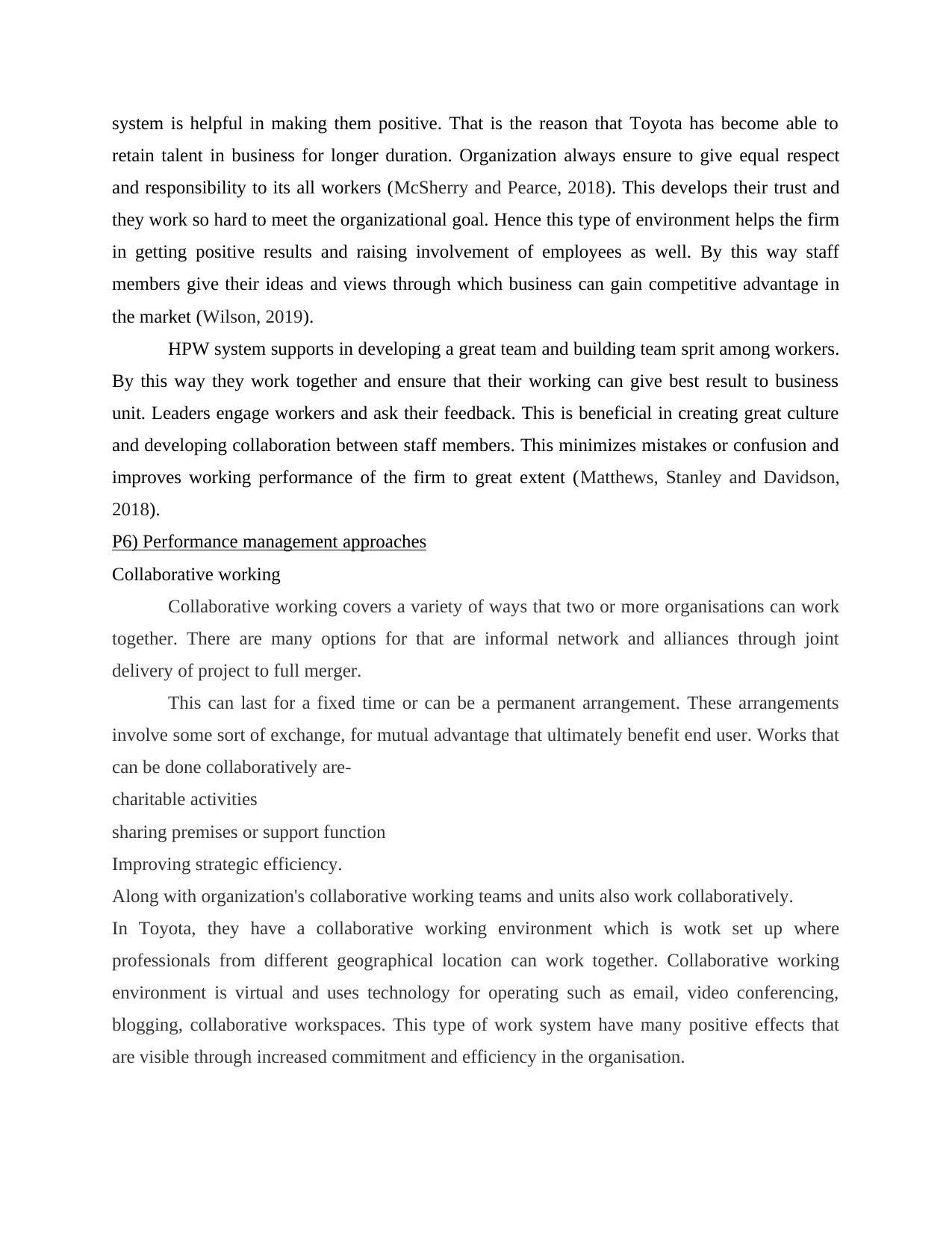
system is helpful in making them positive. That is the reason that Toyota has become able to
retain talent in business for longer duration. Organization always ensure to give equal respect
and responsibility to its all workers (McSherry and Pearce, 2018). This develops their trust and
they work so hard to meet the organizational goal. Hence this type of environment helps the firm
in getting positive results and raising involvement of employees as well. By this way staff
members give their ideas and views through which business can gain competitive advantage in
the market (Wilson, 2019).
HPW system supports in developing a great team and building team sprit among workers.
By this way they work together and ensure that their working can give best result to business
unit. Leaders engage workers and ask their feedback. This is beneficial in creating great culture
and developing collaboration between staff members. This minimizes mistakes or confusion and
improves working performance of the firm to great extent (Matthews, Stanley and Davidson,
2018).
P6) Performance management approaches
Collaborative working
Collaborative working covers a variety of ways that two or more organisations can work
together. There are many options for that are informal network and alliances through joint
delivery of project to full merger.
This can last for a fixed time or can be a permanent arrangement. These arrangements
involve some sort of exchange, for mutual advantage that ultimately benefit end user. Works that
can be done collaboratively are-
charitable activities
sharing premises or support function
Improving strategic efficiency.
Along with organization's collaborative working teams and units also work collaboratively.
In Toyota, they have a collaborative working environment which is wotk set up where
professionals from different geographical location can work together. Collaborative working
environment is virtual and uses technology for operating such as email, video conferencing,
blogging, collaborative workspaces. This type of work system have many positive effects that
are visible through increased commitment and efficiency in the organisation.
retain talent in business for longer duration. Organization always ensure to give equal respect
and responsibility to its all workers (McSherry and Pearce, 2018). This develops their trust and
they work so hard to meet the organizational goal. Hence this type of environment helps the firm
in getting positive results and raising involvement of employees as well. By this way staff
members give their ideas and views through which business can gain competitive advantage in
the market (Wilson, 2019).
HPW system supports in developing a great team and building team sprit among workers.
By this way they work together and ensure that their working can give best result to business
unit. Leaders engage workers and ask their feedback. This is beneficial in creating great culture
and developing collaboration between staff members. This minimizes mistakes or confusion and
improves working performance of the firm to great extent (Matthews, Stanley and Davidson,
2018).
P6) Performance management approaches
Collaborative working
Collaborative working covers a variety of ways that two or more organisations can work
together. There are many options for that are informal network and alliances through joint
delivery of project to full merger.
This can last for a fixed time or can be a permanent arrangement. These arrangements
involve some sort of exchange, for mutual advantage that ultimately benefit end user. Works that
can be done collaboratively are-
charitable activities
sharing premises or support function
Improving strategic efficiency.
Along with organization's collaborative working teams and units also work collaboratively.
In Toyota, they have a collaborative working environment which is wotk set up where
professionals from different geographical location can work together. Collaborative working
environment is virtual and uses technology for operating such as email, video conferencing,
blogging, collaborative workspaces. This type of work system have many positive effects that
are visible through increased commitment and efficiency in the organisation.
Paraphrase This Document
Need a fresh take? Get an instant paraphrase of this document with our AI Paraphraser
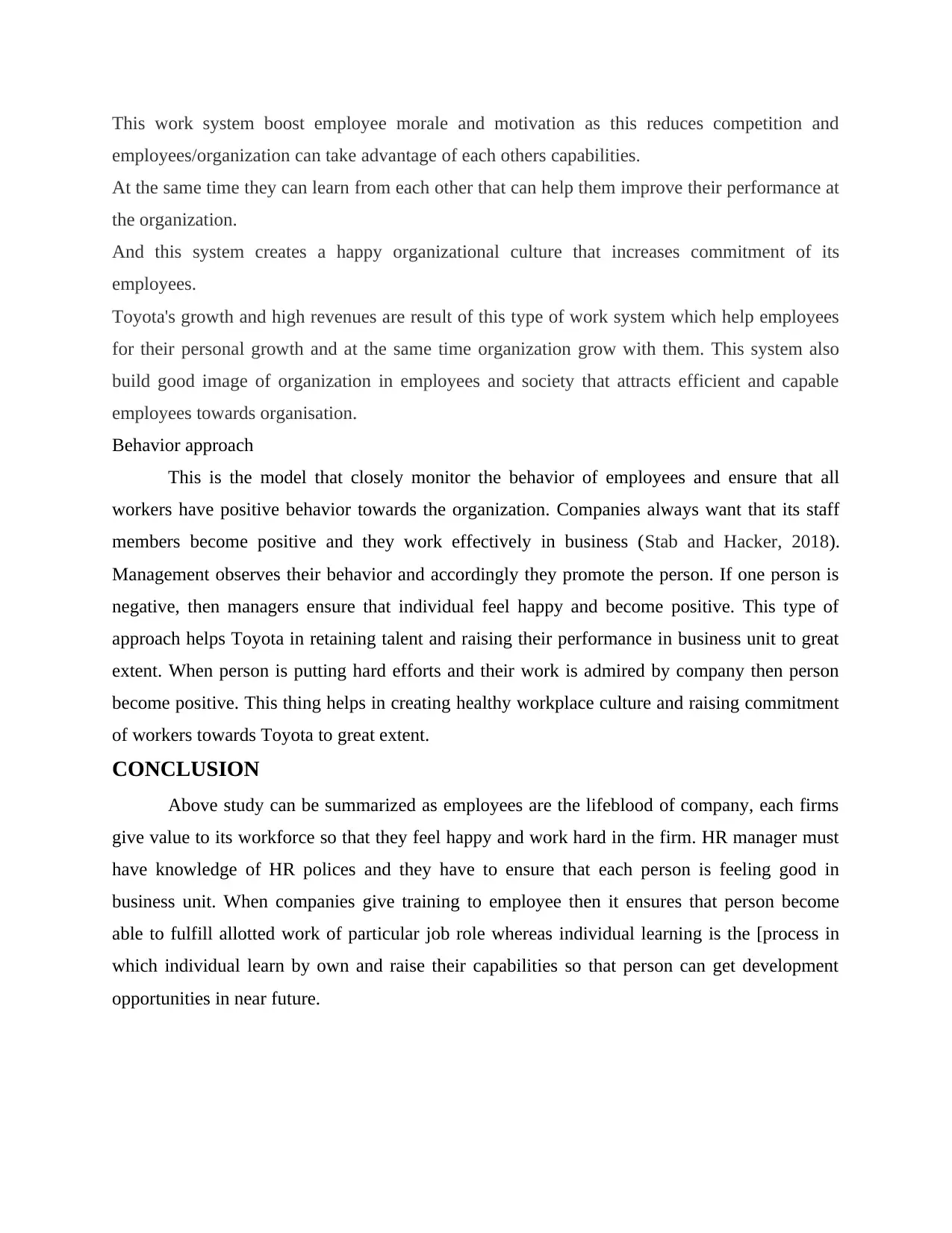
This work system boost employee morale and motivation as this reduces competition and
employees/organization can take advantage of each others capabilities.
At the same time they can learn from each other that can help them improve their performance at
the organization.
And this system creates a happy organizational culture that increases commitment of its
employees.
Toyota's growth and high revenues are result of this type of work system which help employees
for their personal growth and at the same time organization grow with them. This system also
build good image of organization in employees and society that attracts efficient and capable
employees towards organisation.
Behavior approach
This is the model that closely monitor the behavior of employees and ensure that all
workers have positive behavior towards the organization. Companies always want that its staff
members become positive and they work effectively in business (Stab and Hacker, 2018).
Management observes their behavior and accordingly they promote the person. If one person is
negative, then managers ensure that individual feel happy and become positive. This type of
approach helps Toyota in retaining talent and raising their performance in business unit to great
extent. When person is putting hard efforts and their work is admired by company then person
become positive. This thing helps in creating healthy workplace culture and raising commitment
of workers towards Toyota to great extent.
CONCLUSION
Above study can be summarized as employees are the lifeblood of company, each firms
give value to its workforce so that they feel happy and work hard in the firm. HR manager must
have knowledge of HR polices and they have to ensure that each person is feeling good in
business unit. When companies give training to employee then it ensures that person become
able to fulfill allotted work of particular job role whereas individual learning is the [process in
which individual learn by own and raise their capabilities so that person can get development
opportunities in near future.
employees/organization can take advantage of each others capabilities.
At the same time they can learn from each other that can help them improve their performance at
the organization.
And this system creates a happy organizational culture that increases commitment of its
employees.
Toyota's growth and high revenues are result of this type of work system which help employees
for their personal growth and at the same time organization grow with them. This system also
build good image of organization in employees and society that attracts efficient and capable
employees towards organisation.
Behavior approach
This is the model that closely monitor the behavior of employees and ensure that all
workers have positive behavior towards the organization. Companies always want that its staff
members become positive and they work effectively in business (Stab and Hacker, 2018).
Management observes their behavior and accordingly they promote the person. If one person is
negative, then managers ensure that individual feel happy and become positive. This type of
approach helps Toyota in retaining talent and raising their performance in business unit to great
extent. When person is putting hard efforts and their work is admired by company then person
become positive. This thing helps in creating healthy workplace culture and raising commitment
of workers towards Toyota to great extent.
CONCLUSION
Above study can be summarized as employees are the lifeblood of company, each firms
give value to its workforce so that they feel happy and work hard in the firm. HR manager must
have knowledge of HR polices and they have to ensure that each person is feeling good in
business unit. When companies give training to employee then it ensures that person become
able to fulfill allotted work of particular job role whereas individual learning is the [process in
which individual learn by own and raise their capabilities so that person can get development
opportunities in near future.
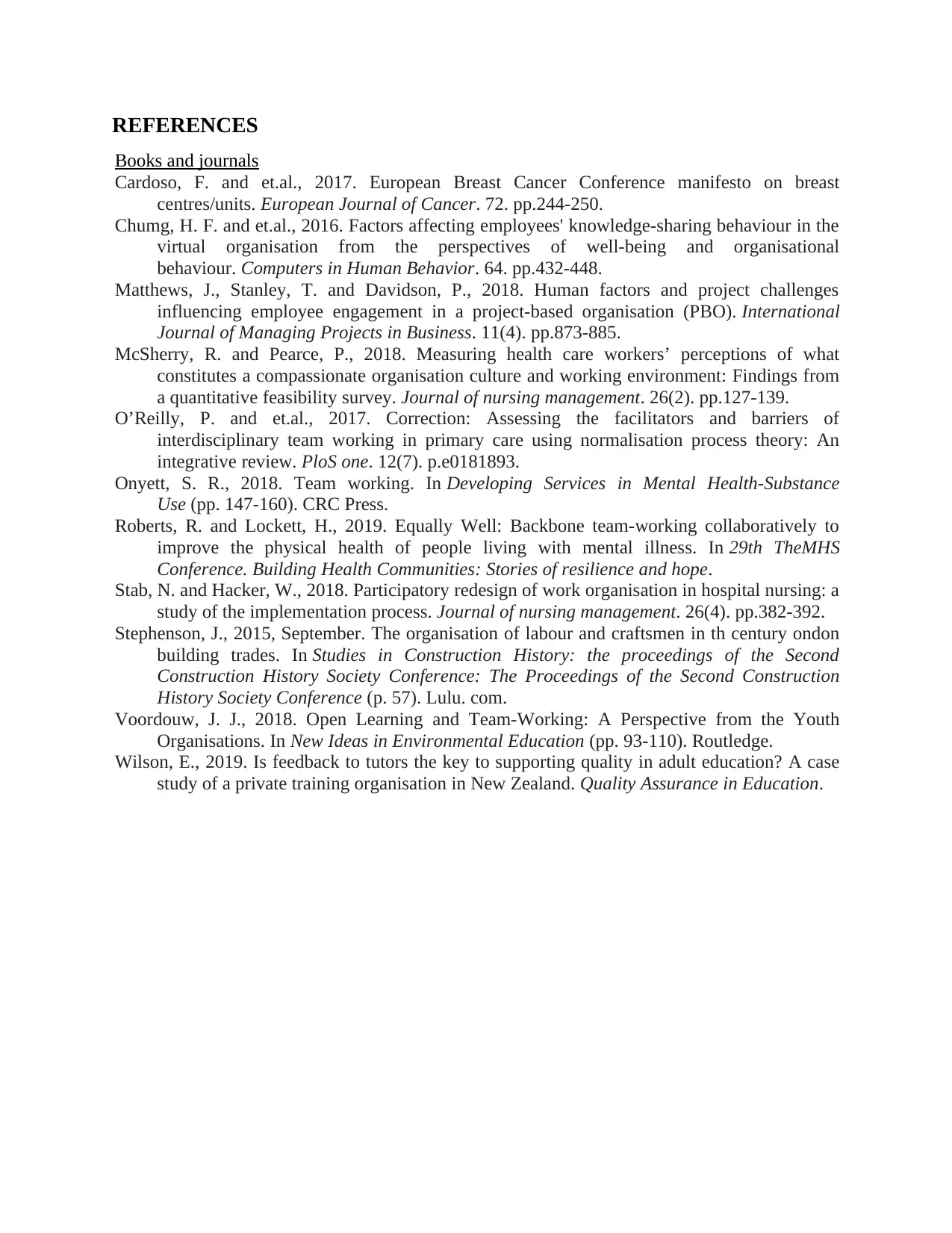
REFERENCES
Books and journals
Cardoso, F. and et.al., 2017. European Breast Cancer Conference manifesto on breast
centres/units. European Journal of Cancer. 72. pp.244-250.
Chumg, H. F. and et.al., 2016. Factors affecting employees' knowledge-sharing behaviour in the
virtual organisation from the perspectives of well-being and organisational
behaviour. Computers in Human Behavior. 64. pp.432-448.
Matthews, J., Stanley, T. and Davidson, P., 2018. Human factors and project challenges
influencing employee engagement in a project-based organisation (PBO). International
Journal of Managing Projects in Business. 11(4). pp.873-885.
McSherry, R. and Pearce, P., 2018. Measuring health care workers’ perceptions of what
constitutes a compassionate organisation culture and working environment: Findings from
a quantitative feasibility survey. Journal of nursing management. 26(2). pp.127-139.
O’Reilly, P. and et.al., 2017. Correction: Assessing the facilitators and barriers of
interdisciplinary team working in primary care using normalisation process theory: An
integrative review. PloS one. 12(7). p.e0181893.
Onyett, S. R., 2018. Team working. In Developing Services in Mental Health-Substance
Use (pp. 147-160). CRC Press.
Roberts, R. and Lockett, H., 2019. Equally Well: Backbone team-working collaboratively to
improve the physical health of people living with mental illness. In 29th TheMHS
Conference. Building Health Communities: Stories of resilience and hope.
Stab, N. and Hacker, W., 2018. Participatory redesign of work organisation in hospital nursing: a
study of the implementation process. Journal of nursing management. 26(4). pp.382-392.
Stephenson, J., 2015, September. The organisation of labour and craftsmen in th century ondon
building trades. In Studies in Construction History: the proceedings of the Second
Construction History Society Conference: The Proceedings of the Second Construction
History Society Conference (p. 57). Lulu. com.
Voordouw, J. J., 2018. Open Learning and Team-Working: A Perspective from the Youth
Organisations. In New Ideas in Environmental Education (pp. 93-110). Routledge.
Wilson, E., 2019. Is feedback to tutors the key to supporting quality in adult education? A case
study of a private training organisation in New Zealand. Quality Assurance in Education.
Books and journals
Cardoso, F. and et.al., 2017. European Breast Cancer Conference manifesto on breast
centres/units. European Journal of Cancer. 72. pp.244-250.
Chumg, H. F. and et.al., 2016. Factors affecting employees' knowledge-sharing behaviour in the
virtual organisation from the perspectives of well-being and organisational
behaviour. Computers in Human Behavior. 64. pp.432-448.
Matthews, J., Stanley, T. and Davidson, P., 2018. Human factors and project challenges
influencing employee engagement in a project-based organisation (PBO). International
Journal of Managing Projects in Business. 11(4). pp.873-885.
McSherry, R. and Pearce, P., 2018. Measuring health care workers’ perceptions of what
constitutes a compassionate organisation culture and working environment: Findings from
a quantitative feasibility survey. Journal of nursing management. 26(2). pp.127-139.
O’Reilly, P. and et.al., 2017. Correction: Assessing the facilitators and barriers of
interdisciplinary team working in primary care using normalisation process theory: An
integrative review. PloS one. 12(7). p.e0181893.
Onyett, S. R., 2018. Team working. In Developing Services in Mental Health-Substance
Use (pp. 147-160). CRC Press.
Roberts, R. and Lockett, H., 2019. Equally Well: Backbone team-working collaboratively to
improve the physical health of people living with mental illness. In 29th TheMHS
Conference. Building Health Communities: Stories of resilience and hope.
Stab, N. and Hacker, W., 2018. Participatory redesign of work organisation in hospital nursing: a
study of the implementation process. Journal of nursing management. 26(4). pp.382-392.
Stephenson, J., 2015, September. The organisation of labour and craftsmen in th century ondon
building trades. In Studies in Construction History: the proceedings of the Second
Construction History Society Conference: The Proceedings of the Second Construction
History Society Conference (p. 57). Lulu. com.
Voordouw, J. J., 2018. Open Learning and Team-Working: A Perspective from the Youth
Organisations. In New Ideas in Environmental Education (pp. 93-110). Routledge.
Wilson, E., 2019. Is feedback to tutors the key to supporting quality in adult education? A case
study of a private training organisation in New Zealand. Quality Assurance in Education.
⊘ This is a preview!⊘
Do you want full access?
Subscribe today to unlock all pages.

Trusted by 1+ million students worldwide
1 out of 14
Related Documents
Your All-in-One AI-Powered Toolkit for Academic Success.
+13062052269
info@desklib.com
Available 24*7 on WhatsApp / Email
![[object Object]](/_next/static/media/star-bottom.7253800d.svg)
Unlock your academic potential
Copyright © 2020–2025 A2Z Services. All Rights Reserved. Developed and managed by ZUCOL.





